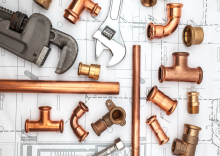Plumbing (Domestic Hot Water) Systems
Plumbing is the system of pipes, drains, fittings, valves, and fixtures installed for the distribution of potable water for drinking, heating and washing, and waterborne waste removal. This module focuses on the interaction of the domestic hot water system with other building components.
Curriculum
-
Remember
- List the two primary purposes of plumbing and the three overall parts of a plumbing system.
-
Describe the difference between a building code, a building standard, and a plumber’s license.
-
Define key plumbing terms, including backflow, back siphonage, branch, building drain, drain, inceptor, potable water, septic tank, trap, vent stack, water flow controls, and water supply system.
: Plumbing - Level 1 - RememberLecture Notes
: Difference between Plumbing TermsProblem Set
: Matching Terms and DefinitionsProblem Set
: Parts of a Plumbing SystemProblem Set
-
Understand
- Identify eight materials used for pipes in plumbing. For three of these materials, describe a positive attribute or use. For the other three materials, describe a negative attribute or why some local codes may prohibit this material for water supply piping.
-
Describe the key attributes of the four basic hot water delivery system types that are used in single- and multi-family homes.
: Plumbing - Level 2 - UnderstandLecture Notes
: Attributes of Core Plumbing SystemsProblem Set
: Attributes of Demand-Initiated Recircuculation SystemsProblem Set
: Attributes of Manifold Plumbing SystemsProblem Set
: Attributes of Trunk and Branch SystemsProblem Set
: Understanding PEX PipingProblem Set
-
Apply
- Sketch the general configuration of the typical trunk and branch, core, whole-house manifold, and demand hot water delivery system types and explain the overall concept of each design.
-
Identify and compile a list of the key plumbing building codes for a residential building in your climate zone.
: Plumbing - Level 3 - ApplyLecture Notes
: Model Codes Related to PlumbingProblem Set
: Sketch Trunk and Branch and Core Plumbing LayoutsProblem Set
-
Analyze
- For your specific climate zone, research, identify, and list key building processes, materials, and design elements plumbers should apply 1) to prevent water leaks and facilitate leak detection and repair and 2) to prevent condensation on cold water lines and fixtures.
-
Analyze how the EPA WaterSense® New Home Specification can be applied to a new home built to code in your climate zone to use approximately 20% less water.
: Plumbing - Level 4 - AnalyzeLecture Notes
: Calculating WaterSense Criteria - Problem SetProblem Set
: Insulation and Air Sealing Related to PlumbingProblem Set
